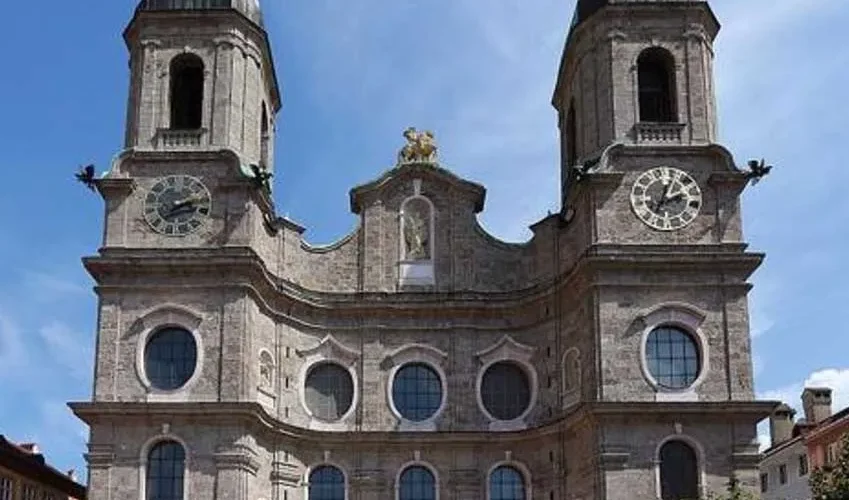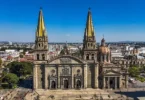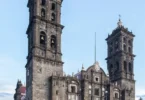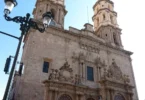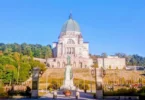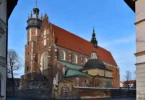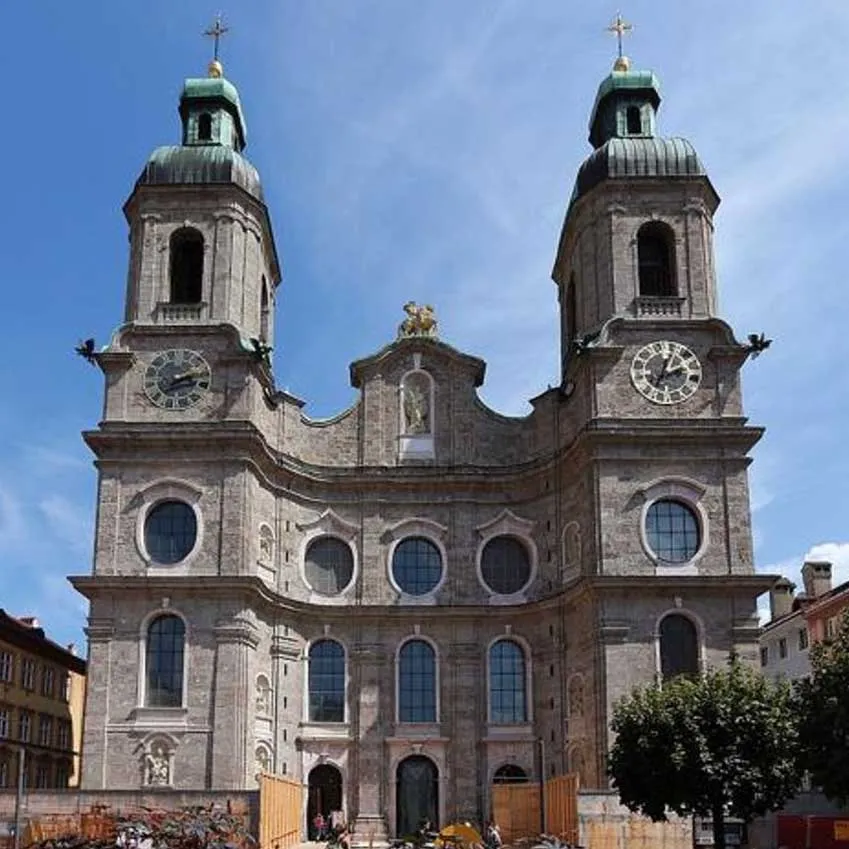
Introduction
The Dom zu Sankt Jakob, also known as the Cathedral of St. James, is a stunning Baroque masterpiece located in the heart of Innsbruck, Austria. This cathedral serves not only as an architectural gem but also a rich historical monument that tells countless tales about its past. Innsbruck Cathedral, officially known as the Cathedral of St. James (German: Dom zu St. Jakob), stands as a majestic Baroque edifice in Innsbruck, Austria. Completed between 1717 and 1724 under the design of architect Johann Jakob Herkomer, the cathedral replaced a 12th-century Romanesque church. Its interior is a testament to Baroque splendor, featuring three elegantly domed vaults that span the nave and a grand dome with a lantern over the chancel. The sumptuous décor, partially crafted by the renowned Asam brothers, makes this cathedral one of the most significant Baroque structures in the Tyrol region.
Among the cathedral’s notable treasures are the revered painting Maria Hilf (Mary of Succor) by Lucas Cranach the Elder, dating to around 1530, which graces the main altar, and the intricate canopied tomb of Archduke Maximilian III of Austria, Grand Master of the Teutonic Knights, located in the north aisle and dating from 1620. Despite suffering extensive damage during World War II, Innsbruck Cathedral was meticulously restored and remains a stunning example of Baroque artistry and historical significance.
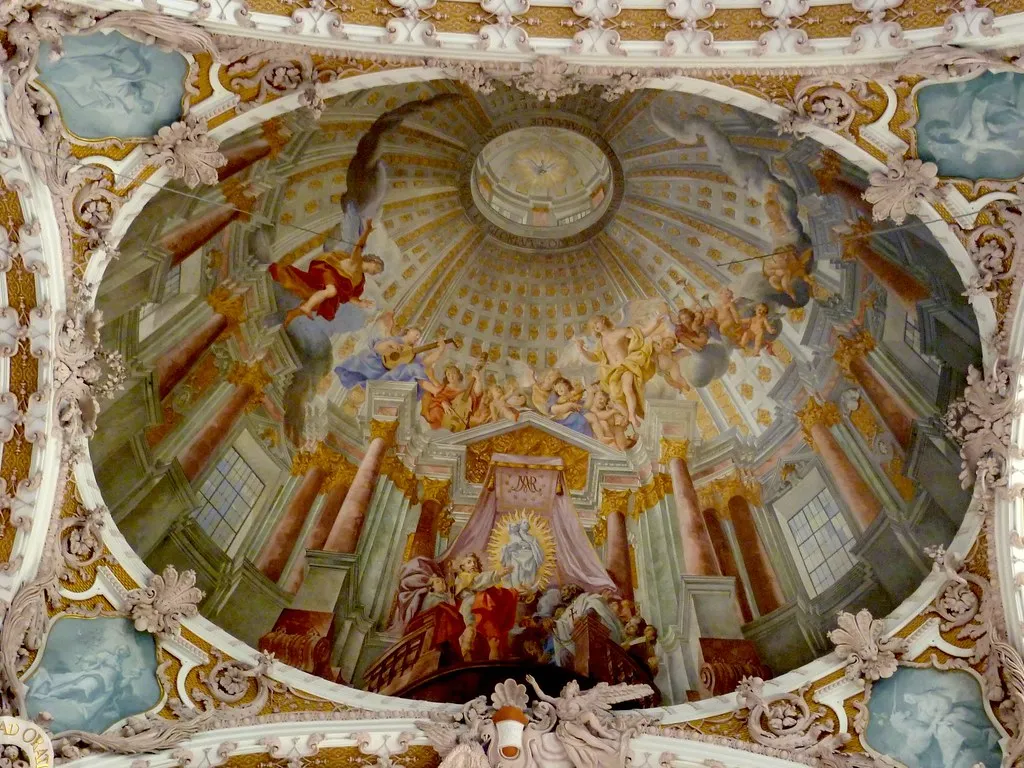
St. James’ Cathedral – or Innsbruck Cathedral as it is often referred to – was mentioned for the first time in 1180. Since then, it has towered majestically over the roofs of Innsbruck and been part of the most important medieval Christian pilgrimage route – the Way of St. James. The cathedral was badly damaged by earthquakes in the 16th and 17th centuries and was rebuilt between 1717 and 1724. Famous German painter Albrecht Dürer also greatly admired the impressive appearance of this significant sacred building and immortalised it in his famous watercolour.
The origins of Innsbruck Cathedral trace back to 1180, when a document authorized the transfer of a market from the left to the right bank of the Inn River, marking the foundation of the old town of Innsbruck. This early reference mentions an “ecclesia in toro,” indicating the presence of a church on the site. By 1187, the construction of the Alte Innbrücke (Old Inn Bridge) and the establishment of a market gave rise to the name “Innsbruck.” The earliest Romanesque church on this site, incorporated into Wilten Abbey, remains shrouded in mystery regarding its appearance and decoration. Throughout the 13th and 14th centuries, the church suffered from frequent fires and earthquakes, necessitating multiple repairs and reconstructions.
In 1438, Nicholas of Cusa significantly funded the enlargement of the church. By 1472, a detailed sacristy inventory recorded numerous liturgical items, including embroidered chasubles and chalices. A watercolor by Albrecht Dürer in 1495 provides the earliest visual depiction of the church, showing a single spire behind the city’s fortified walls. This artwork is now housed in the Albertina in Vienna. During this period, St. James was likely a three-aisled hall church, a common design in southern Bavaria and the Alps. A major renovation in 1551 transformed it into a single-aisled hall, with plans to house Emperor Maximilian I’s tomb. Under Archduke Ferdinand II, notable artists such as Jörg Ebert and Alexander Colyn contributed to the church’s interior.
In 1643, St. James achieved the status of a parish church, independent from Wilten Abbey. By 1650, Archduke Ferdinand Charles donated Lucas Cranach the Elder’s Maria Hilf (“Mary of Succour”), enhancing the church’s significance. Efforts to replace the old church with a safer, earthquake-resistant building gained support from prominent figures. Architect Johann Jakob Herkomer’s design was chosen in December 1716, and construction began in May 1717. After Herkomer’s death in October 1717, his nephew Johann Georg Fischer took over, making only minor changes to the original plans. The cathedral’s dome and towers were completed by November 1720, and Cosmas Damian Asam was selected to paint the ceiling with scenes from the life of Saint James. His work, along with his brother Egid Quirin Asam’s stucco decorations, was completed by 1724 when the cathedral was dedicated by Kaspar Ignaz Count Kunigl, Prince Bishop of Brixen. The nobility and the imperial family generously contributed to the new building, with Empress Maria Theresa donating a silver sculpture and festive vestments. The interior was finalized in 1732.
St. James Cathedral maintained its appearance throughout the 18th and 19th centuries. In 1890, a major interior restoration was undertaken by Albrecht Steiner von Felsburg. However, the cathedral was severely damaged during a World War II air raid on December 16, 1944, which caused the collapse of the vault and the destruction of altars and paintings. Extensive restoration efforts between 1946 and 1950 repaired the damage. In 1964, the cathedral was designated the Cathedral of the Diocese of Innsbruck. The façade was renewed in 1973 to mark the 250th anniversary of its dedication, and a comprehensive interior restoration from 1991 to 1993 addressed remaining war damage. On October 24, 1993, Bishop Reinhold Stecher dedicated the newly restored altar and crypt, concluding a significant chapter in the cathedral’s storied history.
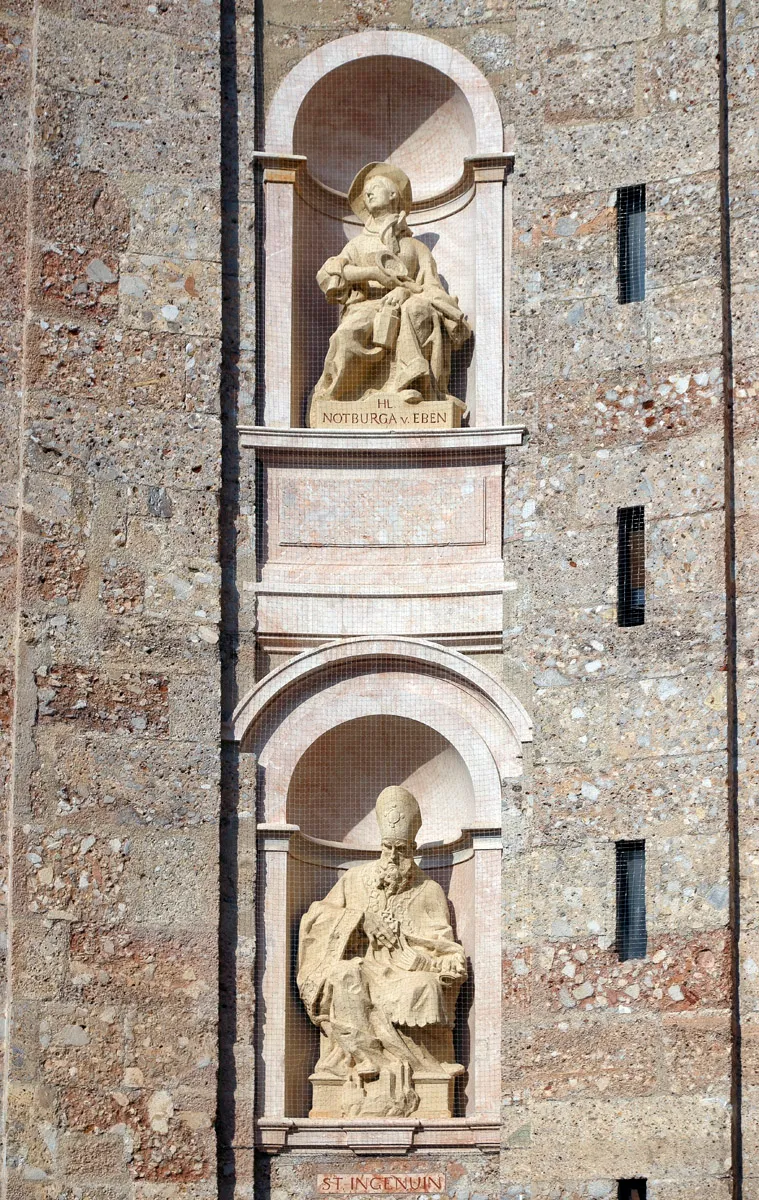
Architectural Style : Baroque architecture
Burials : Maximilian III, Archduke of Austria, Archduke Eugen of Austria
Exterior
Innsbruck Cathedral, with its two bell towers and impressive dome, creates a dominant profile over the Altstadt (Old Town) skyline amidst the many green copper roofs. The stunning backdrop of the Karwendel Alps adds a dramatic effect. The facade, which faces west over the Pfarrplatz, is constructed of Hötting breccia and Hagau marble and is dominated by its two towers. The round arched wall niches in the concave curve of the façade contain limestone statues of saints from the Tyrol: Hartmann, Cassian, Ingenuin, Albuin, Notburga, Romedius, Magdalena of Austria, and Heinrich von Bozen. These statues were created between 1941 and 1960 by Hans Andre, who also created the statue of the Virgin in the façade gable and the equestrian statue of Saint James above it.
The ground plan of the structure is traditional and cruciform with two west towers, a twin-bayed nave, a semicircle transept, and a straight-ended choir, framed by the sacristy and two concluding passages. The nave and transept are covered by saucer domes completely decorated with frescos—the first time in the Tyrol where this decorative technique was used. Another unique element of the building is the placement of the dome above the choir, and not above the crossing which is customary. The architect Herkomer, who was known for bringing together “all the church beauty from German and Latin lands”, chose a Renaissance approach by giving the church a unique architectural element that helped create a symbolic focus on the high altar and tabernacle—a focus later enhanced by the inclusion of the painting Maria Hilf.
Exploring the Majestic Interior of Innsbruck Cathedral

Monumental Design and Spatial Unity
Upon entering Innsbruck Cathedral, visitors are immediately struck by its “severe monumentality.” This impressive effect is achieved through a series of heavy pillars that form a recurring triumphal arch motif. These pillars support saucer domes, which are essentially flat wooden ceilings with concave molding that span the width of the cathedral’s interior. The segmented walls are further defined by marble lesenes on all sides, and the powerful entablature, angling upwards above the windows, creates a dramatic linkage between the groups of windows.
The high dome casts its light over the choir, drawing the eye toward the high altar, which spans the entire width of the choir. Unlike the Baroque churches traditionally built in the Tyrol, which featured segmented, tunnel-vaulted naves with rows of chapels and galleries, this cathedral boasts an expansive interior that achieves a sweeping spatial unity. Architect Johann Jakob Herkomer’s design, which breaks away from partitioned approaches, focuses on the domed choir and high altar, creating a cohesive and unified space.
Stunning Frescoes by Cosmas Damian Asam
The cathedral’s unique character is further defined by its frescoes, painted by Bavarian artist Cosmas Damian Asam. Trained in Italy, Asam was a pioneer in employing optical illusion techniques to create the sense of endless space. His frescoes, which celebrate the life of Saint James, adorn the cathedral’s vaults. In the main dome, Saint James is depicted as a heavenly general leading the Christian army. The spandrels feature the four evangelists, and the side arches show angels associated with Saint James. Additional frescoes in the transept dome and nave illustrate Saint James in various intercessory roles, while smaller spandrel paintings provide allegorical references to the main frescoes.
Exquisite Stucco Work by Egid Quirin Asam
Egid Quirin Asam, Cosmas Damian’s younger brother, created the intricate stucco work that complements the frescoes. Reflecting Renaissance visual vocabulary, his stucco designs enhance the overall aesthetic harmony of the cathedral. The marble floors, noted for their geometric patterns and considered among the finest in Austria, were designed by Christoforo and Theodoro Benedetti. They also crafted the nine altars and the pilasters in the nave from various types of marble. The gilded Rococo ornamentation in the side galleries above the presbytery was added during Empress Maria Theresa’s reign.
The High Altar: A Masterpiece of Baroque Craftsmanship
The high altar is a focal point of the cathedral, showcasing one of the finest examples of late Baroque craftsmanship in Austria. Donated by Prince Bishop Count Künigl and flanked by statues of Saint Ingenuin and Saint Albuin, the altar is adorned with intricate silverwork, including busts of church patrons and Mannerist statuettes. At the heart of the altar is the Maria Hilf (“Mary of Succour”) painting by Lucas Cranach the Elder. This 1530 artwork, a gift from Elector John George I of Saxony, represents a revered Marian image, surrounded by silver angels and golden rays on special occasions.
Beautiful Side Altars and the Pulpit
The cathedral features six large side altars, each donated by brotherhoods or private patrons. The altars closest to the entrance include panels by Johann Georg Dominikus Grasmair, depicting Saint Sebastian and Saint John of Nepomuk, while other altars display a mix of Baroque and Gothic art. The pulpit, a Baroque masterpiece by sculptor Nikolaus Moll, is gilded and silver-plated, adorned with divine virtues, Evangelist symbols, and cherubs. Moll also crafted the magnificent organ front, regarded as one of the most beautiful Baroque organs in the Tyrol.
Stations of the Cross
Completing the cathedral’s Baroque interior are 14 stations of the cross, painted by Michael Ignaz Mildorfer in 1734. Originally displayed in the former convent church in Innsbruck, these two-meter high artworks add a poignant and historical touch to the cathedral’s rich visual narrative.
The Monumental Tomb of Archduke Maximilian III of Austria
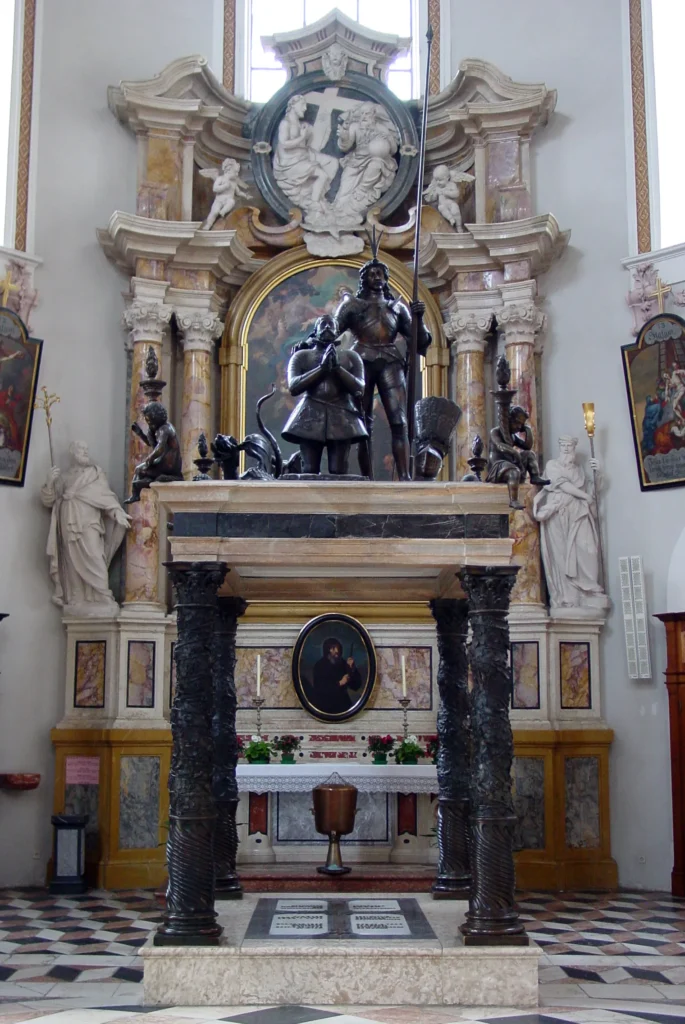
A Masterpiece of Mannerist Sculpture
In the left arm of the transept, the canopied tomb of Archduke Maximilian III of Austria stands as a remarkable work of art and history. Commissioned by the ruler of Tyrol, this tomb is of “great artistic and historical significance” and was designed by the renowned sculptors Hubert Gerhard and Caspar Gras, with casting by Heinrich Reinhard in 1618. Initially erected in the side chapel of the old parish church in 1629, the tomb underwent modifications during the early eighteenth-century reconstruction of the church. The canopy was divided into two sections, which framed the doors of the sacristy. During the post-war restoration of 1950, these sections were reassembled above the tomb in its current location, restoring its original grandeur.
The Design and Symbolism
The tomb’s canopy, functioning as a ciborium, is supported by four intricately turned bronze columns. Adorned with vine leaves, birds, and small animals, these columns feature fluted bases and detailed composite capitals. They uphold a heavily profiled marble entablature, which acts as both a decorative feature and a platform for the bronze figures. At the heart of the composition, a bareheaded Archduke Maximilian kneels in prayer on a cushion, clad in armor. Behind him stands Saint George, resting his hand on the archduke’s shoulder, with the slain dragon visible in the background. The entablature’s front corners are graced by mourning figures holding torches. These finely detailed bronze figures exemplify the highest quality of Austrian Mannerist sculpture. The tomb also commemorates Archduke Eugen, the last Grand Master of the Teutonic Order, who was interred here in 1954.
The Life of Archduke Maximilian III
Maximilian III, born in Wiener Neustadt in 1558, was the fourth son of Emperor Maximilian II and Empress Maria of Austria. In 1585, he became the Grand Master of the Teutonic Order, earning the epithet “the German Master” (der Deutschmeister). In 1587, he was a contender for the throne of the Polish-Lithuanian Commonwealth, where he received some support from the Polish nobility. However, a contentious election process led to another candidate being chosen. Maximilian’s attempt to settle the dispute through military means triggered the War of the Polish Succession. Despite his considerable support in Poland, he was ultimately defeated at the Battle of Byczyna in January 1588 and captured. He was released through the intervention of Pope Sixtus V and renounced his claim to the Polish crown in 1589. In 1595, he succeeded his uncle Ferdinand II as Archduke of Further Austria and Governor of Tyrol, where he was a staunch supporter of the Counter-Reformation. Maximilian passed away in Vienna in 1618 and was laid to rest in his magnificent tomb in Innsbruck Cathedral.
The Tomb of Archduke Maximilian III: A Monument of Historical Significance
The tomb of Archduke Maximilian III, the Teutonic Master, is a remarkable piece of art and history. Crafted by the renowned sculptor Hubert Gerhard (circa 1540/50 – circa 1620/30) and his apprentice Caspar Gras, and cast by Heinrich Reinhart in Innsbruck in 1619, this impressive monument was originally placed in the old parish church. The tomb features the Teutonic Master Maximilian depicted kneeling on a four-columned structure, with St. George, the patron saint of the Teutonic Order, providing protection.
During the cathedral’s reconstruction, the monument was divided and repurposed to frame the two chancel doors. However, in 1950, it was carefully restored to its original form and reinstalled in the cathedral.
Notably, the inscription on the gravestone to the right honors Archduke Eugen, the final Grand Master of the Teutonic Order from the House of Habsburg, who was also laid to rest here
The Bells of St. James Cathedral: A Harmony of History and Tradition
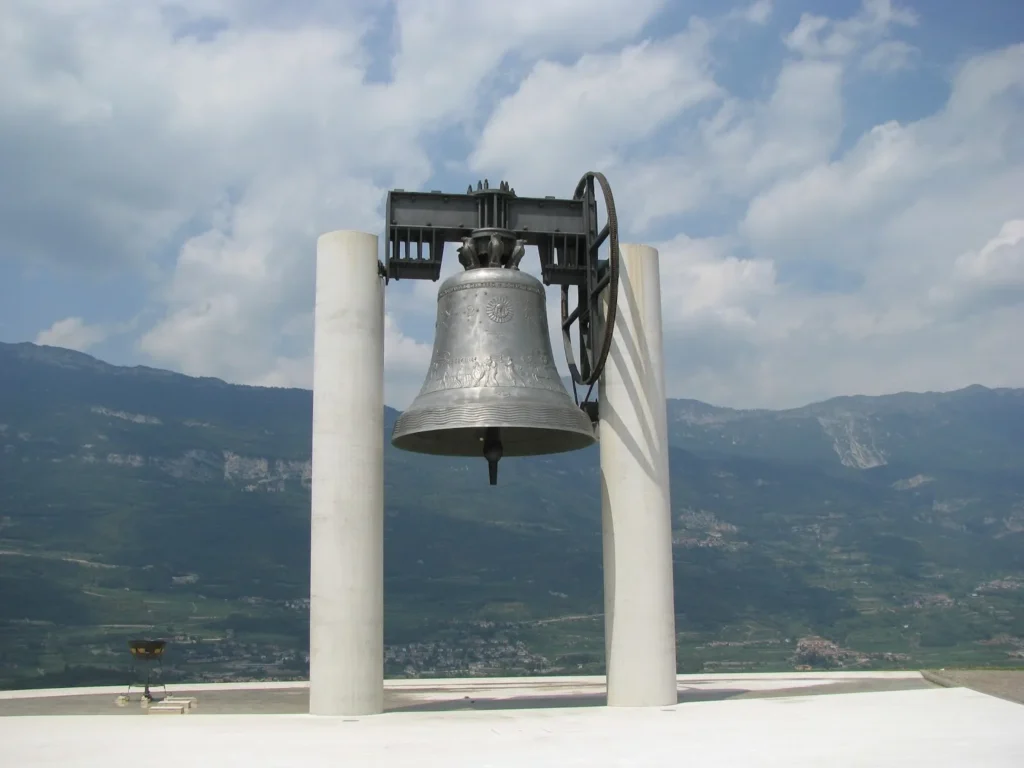
Historical Bell: The Mariahilfglocke
The bells of St. James Cathedral have a long history, with the first documented mention dating back to 1394. Among the cathedral’s notable bells is the Mariahilfglocke, also known as the Große Pfarrglocke. Cast in 1846 by the renowned Grassmayr Bell Foundry, the Mariahilfglocke is the second-largest historic bell in Tyrol. It boasts an impressive diameter of 2,210 mm (87 inches) and a weight of 6,342 kg (13,982 lbs). This monumental bell resides in the north tower and chimes every Friday at 3:00 pm to mark the hour of Jesus’s death, continuing a revered tradition.
The Modern Bells
In the 1960s, St. James Cathedral’s bell collection was expanded with seven new bells crafted by Johann Grassmayr from the same foundry. These bells were installed in the south tower, each dedicated to a different saint, with the exception of one, known as the Totenglocke (Death Knell). These additions enriched the cathedral’s musical heritage and further connected it with the community.
The Innsbruck Peace Carillon
A significant enhancement to the cathedral’s bell ensemble came in 1982 with the installation of the Innsbruck Peace Carillon in the north tower. This carillon is the largest and most extensive in Austria, comprising 48 bells with a combined weight of 4,100 kg (9,000 lbs). Cast by the Royal Eijsbouts Bell Foundry, the Innsbruck Peace Carillon plays daily around 12:10 pm and features a remarkable four-octave range. It is part of the War Memorial and Peace Carillons network, underscoring its role in commemorating peace.
The Miraculous Image of Mariahilf: A Storied Journey Through History
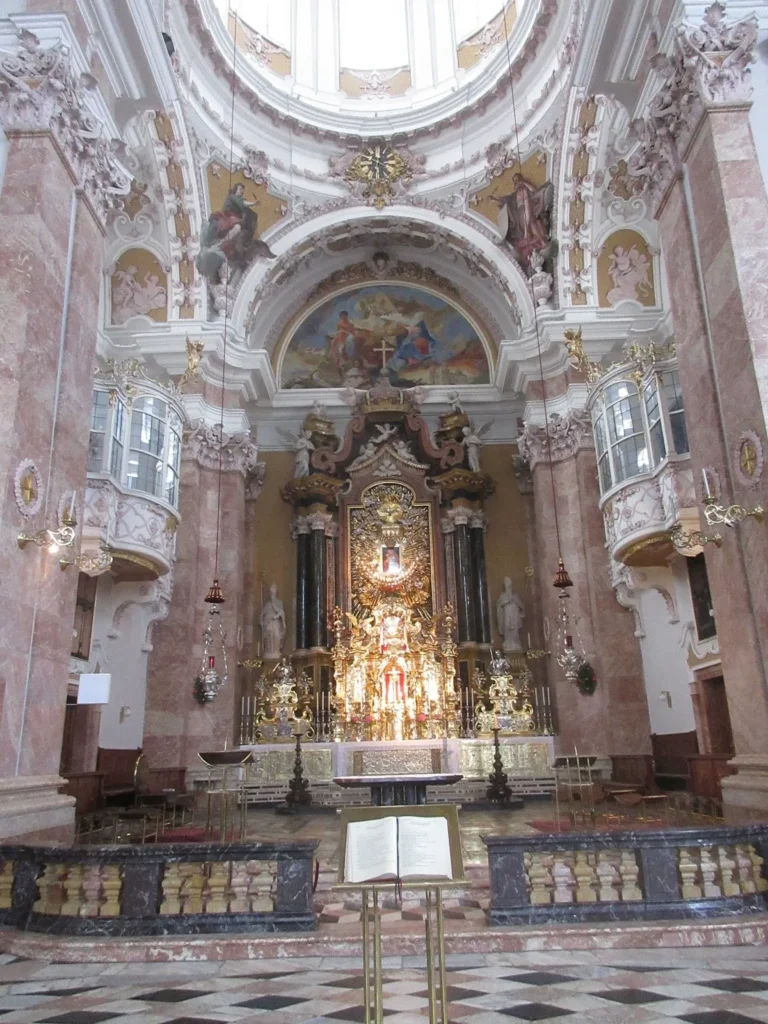
The “Mariahilf” image, a masterpiece painted by Lucas Cranach the Elder around 1537, boasts a rich and storied history. Originally housed in the Holy Cross Church in Dresden, this revered painting made its way into the Electoral Painting Collection. In a gesture of profound significance, Elector George I of Saxony presented the painting as a gift to Archduke Leopold V, who served as Bishop of Passau before becoming Prince of Tyrol. Throughout the Thirty Years’ War, the “Mariahilf” image was a focal point of Marian devotions, earning widespread veneration. By 1650, it was enshrined in the city parish church, and with the construction of a new church building, it was prominently placed on the high altar.
The “Mariahilf” image is renowned as one of the most influential depictions of the Virgin Mary throughout the Alpine and Central European regions. During the Second World War, its significance was safeguarded when it was transported to the Ötztal for protection. Since 1750, the transfer of the “Mariahilf” image has been commemorated annually in July with the “Säkulumsfest.” The celebration reached new heights in 2000 with a week-long festival marking the 350th anniversary of its transfer, highlighting the enduring legacy and deep cultural significance of this cherished artwork.
Explore the Sacrament Chapel: A New Sanctuary for Reflection

In November 2000, St. James’ Cathedral introduced the Sacrament Chapel, a serene new space dedicated to quiet reflection and prayer. Located in the south tower of the cathedral, adjacent to the lower church, this tranquil oasis was established to mark the anniversary year. The chapel’s simple yet profound design—featuring a tabernacle and a candle—invites visitors to pause and engage in prayer.
The bishop’s vision for this sacred space is to help individuals reconnect with their Christian calling. A powerful reminder of this mission is found in the chapel, where a verse from the Gospel of Matthew is prominently displayed: “The harvest is great, but the workers are few. Ask the Lord of the harvest to send out workers for his harvest.” This verse underscores the chapel’s purpose, encouraging all who enter to reflect on their role in the broader spiritual community.
The Evolution of St. James’ Cathedral Organ: A Journey Through Time
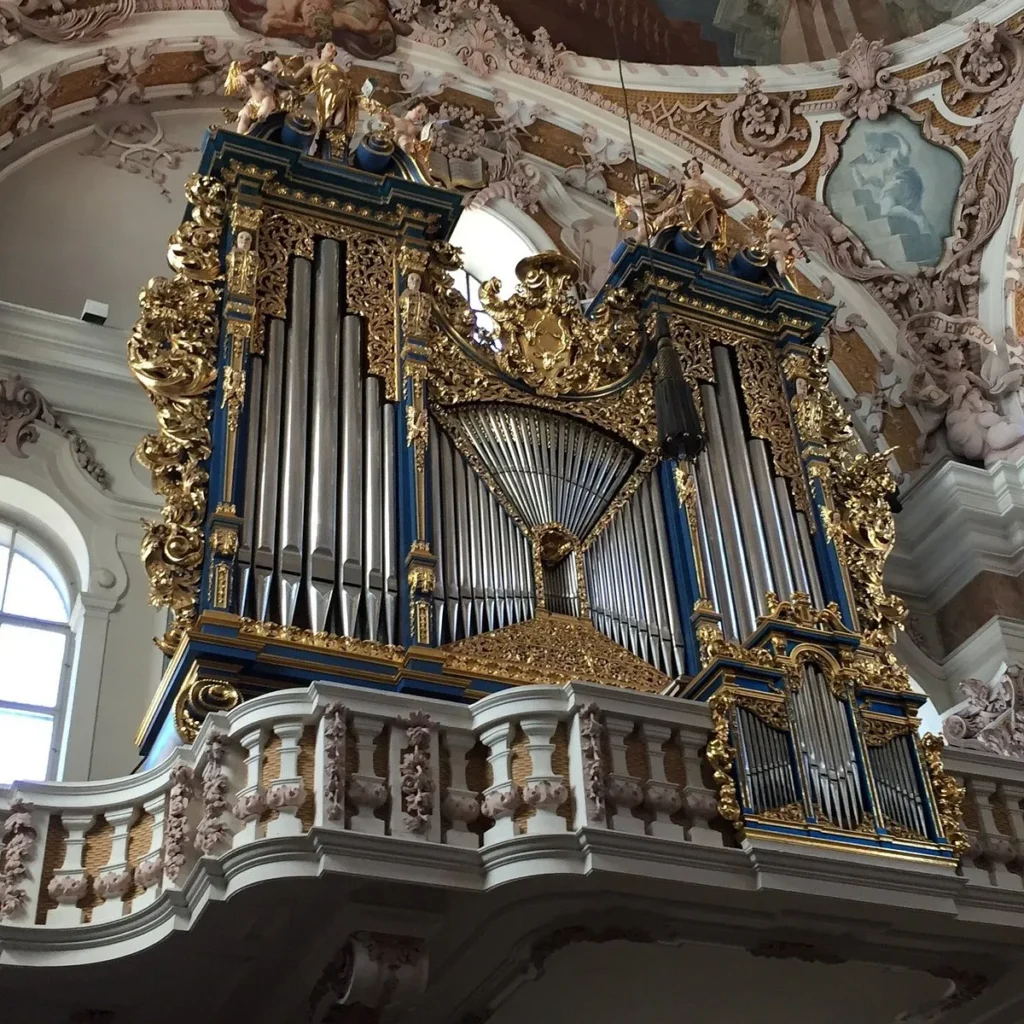
The story of St. James’ Cathedral organ spans centuries of craftsmanship and restoration. The original organ was completed in 1725, just a year after the baroque parish church’s consecration, and was dedicated on the Feast of the Nativity of Mary (September 8). Donated by parish priest Dr. Matthias Tausch, who sadly passed away in May of that year, this inaugural instrument was built by Johann Kaspar Humpel from Merano. By 1873, the idea of repairing the aging organ evolved into a full reconstruction, which was carried out by Joseph Sies of Bolzano in 1875. However, subsequent restoration work on the cathedral’s frescoes and stucco led to significant contamination in the organ area. Consequently, a new organ was commissioned and constructed by Franz Reinisch in Steinach am Brenner in 1892. This new instrument featured 33 registers, with only 6 registers retained from the previous Humpel/Sies organ. The Reinisch organ proved durable and was relocated to the new parish church in Hötting in 1931.
In 1931, the Rieger company from Jägerndorf installed a 75-register electro-pneumatic mechanism, including 10 registers in a remote mechanism housed in the dome. Unfortunately, the organ’s facade suffered damage during World War II bombings, and the instrument’s technical and tonal quality fell short of expectations. As a result, the Federal Monuments Office decided against preserving it. Thanks to generous support from Commercial Councillor DDr. Herbert Batliner of Liechtenstein and the state of Tyrol, a new, purely mechanical organ was commissioned. The old organ was removed and donated to the Breitenfeld parish in Vienna-Josefstadt. The contract for the new organ was awarded to the Pirchner company in Steinach am Brenner.
The current organ, inaugurated on July 1, 2000, boasts 57 registers across 3 manuals and pedals. Efforts were made to preserve the casing structure from the previous organ, with the main casing pipes arranged in a fan shape, although they are non-functional. The new organ features a total of 3,729 pipes. During the installation, it became clear that extensive repairs were needed for the organ casing, which were expertly handled by the Wehinger/Heel company. The result is a magnificent instrument that continues to enhance the cathedral’s rich musical heritage.
Feast Day
Feast day : July 25
St. James’ Cathedral, known as Dom St. Jakob in Innsbruck, Austria, celebrates its feast day on July 25. This date commemorates St. James the Greater, the patron saint of the cathedral and a key figure in the Christian tradition. On this special day, the cathedral observes various religious services and festivities, reflecting its rich history and spiritual significance.
Church Mass Timing
Worship Schedule and Dates
Sundays and Public Holidays:
- 10:00 a.m. Holy Mass
- 11:30 a.m. Holy Mass
Working Days:
- 08:55 am Rosary
- 09:30 a.m. Holy Mass
Church Opening Time:
Opening hours of the cathedral:
- Daily 08:45 m. – 06:30 p.m.
From May 2nd to October 26th the cathedral will be open daily until 7:30 p.m.
Contact Info
Address:
Dompl. 6, 6020 Innsbruck, Austria
Tel : +43 512 583902
Accommodations
Connectivities
Airway
The Basilica of Dom St. Jakob, Dompl. 6, 6020 Innsbruck, Austria is Innsbruck Airport, Fürstenweg 180, 6020 Innsbruck, Austria 10 min (3.8 km) via Höttinger Au and Fürstenweg. away from the Basilica.
Railway
The Basilica of Dom St. Jakob Innsbruck Cathedral, Austria, Innsbruck Station Alps Zoo, 6020 Innsbruck, Austria 7 min (2.2 km) via Innstraße and Weiherburggasse, away from the Basilica.

